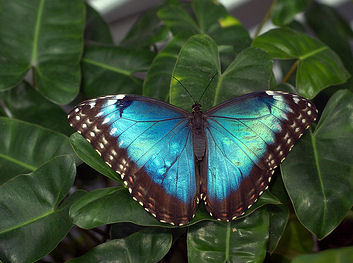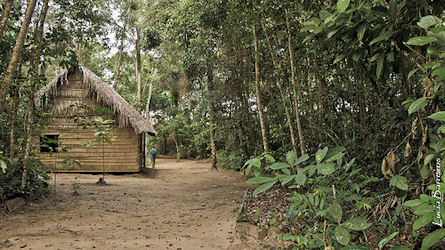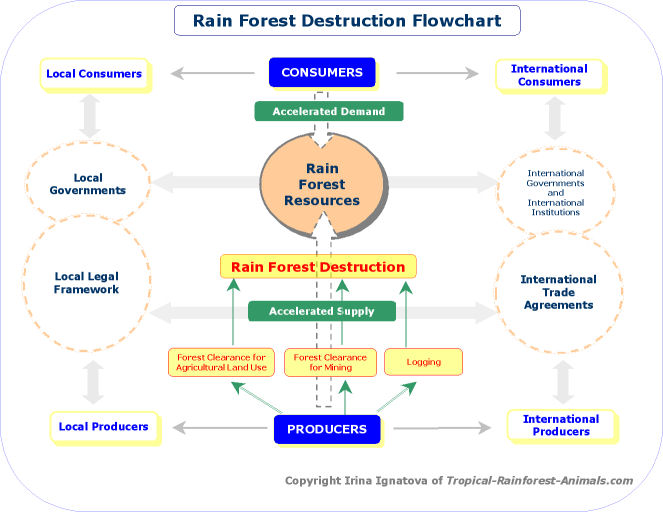Morpho Butterflies Conservation
By Irina Bright.
This article is part of our Environment section
See the complete list of all our Articles about Rainforest Animals here.
As more species of butterflies come under threat due to habitat loss and increasing exploitation by humans, morpho butterflies conservation will play a greater role in helping to secure a safe existence for these beautiful insects in the future.
 Morpho Butterfly
Morpho Butterfly© David Goehring
Although the International Union for Conservation of Nature and Natural Resources (IUCN) has not conducted any formal assessment on the conservation status of morpho butterflies and has not explicitly designated their species as threatened ones, nature-lovers around the world are understandably concerned about the morphos' general well-being.
Morpho butterflies are neotropical animals - they inhabit the rainforests of Central and South America.
Over the last several decades, tropical ecosystems have come under enormous pressure forced upon them mostly by human demands.
Rainforests are ubiquitously cleared for "cash-crop" plantations (ex., coffee) and pastures for livestock. Plantations and pastures provide livelihoods for local people.
But clearance of rainforests means loss of habitat for butterflies and many other plant and animal species which depend on the forests for their basic biological needs.
Habitat loss is, no doubt, one major cause that can seriously endanger morpho butterflies in the long-run.
It also leads to the loss of biodiversity on a wider, global scale as well.
Some Approaches to Morpho Butterflies Conservation
Habitat Preservation and Restoration
Research shows that butterflies tend to be attracted to areas with a high diversity of trees and other plants (ex., riparian forests). This happens because such locations provide them with more options for obtaining food - nectar and rotting fruits.
 Amazon Rainforest, Taruma, Brazil
Amazon Rainforest, Taruma, Brazil© Lubasi
On the other hand, areas with lower plant diversity (ex., secondary forests) host smaller butterfly numbers than biologically richer areas. (Ref. 1)
Thus we are led to conclude that morpho butterflies conservation should, first and foremost, focus on habitat preservation.
Somehow, we need to make sure that forests are not destroyed by some big corporations or unscrupulous individuals alike seeking to enrich themselves at the nature's expense.
Second, in order for conservation to be successful, all stakeholders have to be taken into account.
Farmers and other local inhabitants will always play the most important role in rainforest conservation. They live on forested (or deforested) lands and they certainly know their value, but if they can't feed their families - nothing will persuade them "to preserve the nature".
And animals, such as morpho butterflies, end up being caught in between a rock and a hard place.
That is why it is crucial to find a compromise, so to say, between the local people's needs and the nature.
I have seen many experts referring to silvopastoral systems as a possible solution to meet the needs of "all the parties".
Here is how silvo pastures work.
Pastures with grazing domesticated animals (ex., cows) are planted with trees - thus creating a mini-forest, hopefully, with many different species of trees as opposed to just a single one.
Animals roam and feed on grass or crops around the trees. The tree cover remains intact and can become an excellent home for other animals, in our case morpho butterflies.
So farmers make an income from their cattle, trees are intact and a multitude of animals thrive in a completely natural environment.
We could probably call it a contribution of silvo pastures to morpho butterflies' habitat restoration.
Indeed, if "silvopastoral systems [can potentially] increase habitat quality, quantity and connectivity in pasture dominated landscapes" (ref. 2), they are certainly worth a try.
Reduction in National and International Demand for Rainforest Resources
Most rainforest animals who are now endangered suffer from rainforest destruction in one way or another. Morpho butterflies are no exception - except that they have not yet been formally identified as "endangered".
The fundamental cause of all rainforest destruction is an excessive demand for rainforest products (ex., foods & timber).
This excessive demand inevitably leads to over-exploitation of rainforest resources. Too many crops are extracted from rainforests without giving them a chance to regenerate themselves. Too many trees are cut down for timber without giving them a chance to re-grow.
Have a look at the chart below - it demonstrates very well how accelerated demand affects the rainforests.

Our biggest challenge is to persuade people around the world to CONSUME LESS of everything.
This is one real, fundamental solution to deforestation and habitat loss for animals.
And ... it can certainly help save morpho butterflies as well.
Written by: Irina Bright
Original publication date: 2012
Republication date: 2020
References
1. Tobar, D. and Milder, J.C (2009). Conserving butterfly diversity in agricultural landscapes in Copán, Honduras and Matiguas, Nicaragua, Final Report. The Rufford Small Grants Foundation. Retrieved November 16, 2012 from http://www.ruffordsmallgrants.org/files/53.01.08%20Detailed%20Final%20Report.pdf
2. Ibid.